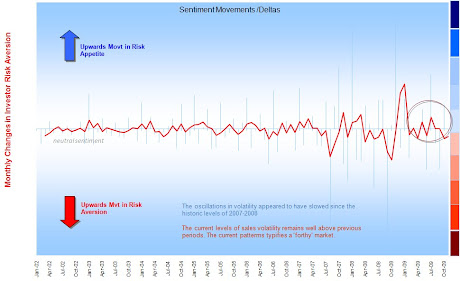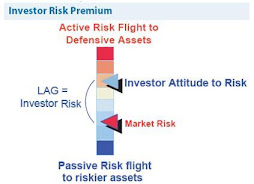John Marke is very right: that some did point to the man-made element, that behaviour will ultimately always produce risk due to morale hazard and it's interesting to see Minsky being revived widely, JM Keynes also.
These then are man-made events but perhaps not in the way of induced seismicity that we have discussed before. But in common is that the intention was not to cause an 'earthquake', well perhaps except the hedge and leveraged managers.
The problem is that the financial industry is a trans-national network that's far more complicated that the multitude of micro silos that trade, invest, comment, regulate and ultimately impact the systemic attributes across the globe. It's too complicated for any one individual or organisation to centre in one place sufficiently long-enough to measure the level of systemic risk, not helped by the simple fact that cross-border regulation is honourable but often ineffective. Even if someone did then the system would probably change so quickly that a true picture could never be built up. It's why scenario analysis should have been more important that forecasting sims. Of course as NNT points out even if we did we are to assymetrical in our guesses, print to underestimate and overestimate at the wrong times.
Again we tried to become too clever, to relax risk limits by inviting more complex risk measurement. Paradox: we chased the holy grail of risk (simply) to elevate one's own risk control/complexity and didn't see the obvious risks in our neighbours kitchen, regulators and BIS enticed such practices but couldn't spin all the plates, not even close, the end.
As John will tell you it's difficult to place lines where we tipped over as we are dealing with a sequence of events that we badly recount but be confident that a multitude of events led to that 'point' in 2008.
Also - in my paper I'm trying to look at the man-made angle from investor herding, media volatility/influence, empirically (I hope) and from a sociological pov. We have to look at the move to DIY investing, online, internet media. I worked out a basic mind map just for this simple fraction of the puzzle and even then was quickly overloaded.
Take also S&P - did months of complacency followed by conservatism lead eventually to radicalism? Markets would indicate no one expected 3 sovereign Euro downgrades in such a short space (Finch may disagree). One would even think S&P wanted to precipitate a double dip or to nervous of not calling something larger, sooner? Be in no doubt the euro is injured and hard to see what conseuqnces that could have. Germany as we know is the cornerstone of the Euro economy,we don't know what caapcity it has to bolster its sick relatives.
Lastly OTC off balance sheet trades (aka dark liquidity pools). The move to bring them into the light and onto exchanges - can we predict the result of this, amplified as it could be through high frequency trading which is completely shaking up the system - John for you this means even less 'slack'.. again a man-made development. We also have baby boomers ready to sell to take their pensions and huge Instl money ready to transfer from trust-based schemes to individuals. Again man-made, cultural, changes will probably be exponential, error rates spiralling and consequences behavioural in nature.
The system will again adapt, evolve, people's mind sets will prefix on the recent and forget the long.. regulations will stem the risk of the known rather than the unknown, this we can be fairly certain just as we can be un-certain of what events will precipitate the next crash or when.
of course if we follow NNT's thinking through, we wouldn't know which black swans hadn't occured in order to apply hindsight as to why they were near misses. What chance do we have - we're not even very good (as a society) in recognising the black swans that do occur.. ergo NNT's crusade on historians and the narrative fallacy. As you say we have to hope for more grey feathers.
Perhaps we can only hypothesise: E.g. what if the awful events of 9/11 hadn't happened resulting in a continuous bubble/affluence run (bond dip) from 1998 all the way through to 2006; (unlikely admittedly) then what?
For example say that the market, somehow, had cooled techs enough to consolidate earnings and precipitate a period of growth not seen since the 50s.. then we see a more prolonged credit boom followed by a bust 3 times the drawdown of 2008-2009. or in another way we add up the sum of the 2000 dot com slide, 9/11/01 + the 2002 accounting scandals and the 2007-2008 crunch together, combined with an assumption that assets were attracted West to East China and EM Mkts overheated 3 fold than they did.. sometimes what may be commented as a balck swan was more predictable, a grey swan, a pressure releases that avoided something much larger such as a complete collapse of electronic international trade.. or China repartiates all foreign assets held, how many institutions would have gone bust then.
John is right about morale hazard and I also follow Minsky. Of course this is all the more unlikely since it is when there is a big error in the system that the next set of models are created as a solution; designed to more accurately measure risk, with the net effect of more risk being taken. Fewer mistakes then the rate of complexity slows. In terms of Minksy think of it as clever bods being encouraged to find complex problems to invent complex solutions that by their application induce more risk-taking. Market shocks ramp up the hire of said bods who have to find new models to get paid. Rarely are bods paid to come up with risk models that cap the amount of risk (profits) their pay masters can undertake.
What if the war on terror hadn't happened, what if no SARS, what if no x, y or z.. as NNT reminds us it is very difficult indeed to unpick the causality of a major event back to a single cause whereas we can hypothesise about the impact of small events, iterating in their multitude, down a butterlfy effect.
There are some huge issues still largely dormant in the financial system, the shifting influence of Gen Y from X investors, the impact of individual vs. institutional investing, advised to non-advised investing, the pensions gap.. the way exchanges are trading, the rate p/second they are trading at: all these things could move the markets up/down to unprecedented scales. They are grey swans since we are talking about them. What do we do about these, hypothesise?
To revive: "For the ordinary man is passive. Within a narrow circle he feels himself master of his fate, but against major events he is as helpless as against the elements. So far from endeavoring to influence the future, he simply lies down and lets things happen to him.." G.O. 'Animal Farm'..and to me that's the only thing regulators and investors seem to do; feeling powerless to change the big events they hypothesise the results from small decisions. In doing so they remain in mediocristan where it feels safer.
In reality they should recognise the shortcomings of future-gazing and build some honest 'resilience' (to coin from John's work) for when things do turn out differently. However the financial markets are a confidence game, always have been and folks need regular placebos to maintain that veil of certainty.
(this thread continue in the Linkedin Black Swan group)
http://www.linkedin.com/groupAnswers?viewQuestionAndAnswers=&gid=80474&discussionID=18503539&commentID=15601226&goback=%2Eanh_80474&report%2Esuccess=8ULbKyXO6NDvmoK7o030UNOYGZKrvdhBhypZ_w8EpQrrQI-BBjkmxwkEOwBjLE28YyDIxcyEO7_TA_giuRN#commentID_15601226




No comments:
Post a Comment
Note: only a member of this blog may post a comment.